AI Carbon Footprint Management Market Size 2025-2029
The AI carbon footprint management market size is valued to increase by USD 4.07 billion, at a CAGR of 23.6% from 2024 to 2029. Intensifying regulatory pressure and mandatory disclosures will drive the ai carbon footprint management market.
Major Market Trends & Insights
- North America dominated the market and accounted for a 35% growth during the forecast period.
- By Deployment - Cloud-based segment was valued at USD 628.90 billion in 2023
- By Type - Carbon accounting and measurement segment accounted for the largest market revenue share in 2023
Market Size & Forecast
- Market Opportunities: USD 503.64 million
- Market Future Opportunities: USD 4071.40 million
- CAGR from 2024 to 2029 : 23.6%
Market Summary
- The market is experiencing significant growth as businesses increasingly prioritize decarbonization and regulatory compliance. According to recent reports, the market is projected to reach a value of USD12.5 billion by 2026, underscoring its growing importance. This expansion is driven by intensifying regulatory pressure and mandatory disclosures, which necessitate the adoption of advanced technologies to measure, monitor, and reduce carbon emissions. In response, generative AI is emerging as a strategic co-pilot for decarbonization efforts. By analyzing vast amounts of data, AI algorithms can identify inefficiencies, optimize energy usage, and suggest carbon-reducing strategies.
- However, the pervasive data gaps and lack of standardization pose challenges to the market's evolution. Despite these hurdles, the future direction of the market remains promising, as businesses continue to seek innovative solutions to mitigate their environmental impact and ensure regulatory compliance.
What will be the Size of the AI Carbon Footprint Management Market during the forecast period?
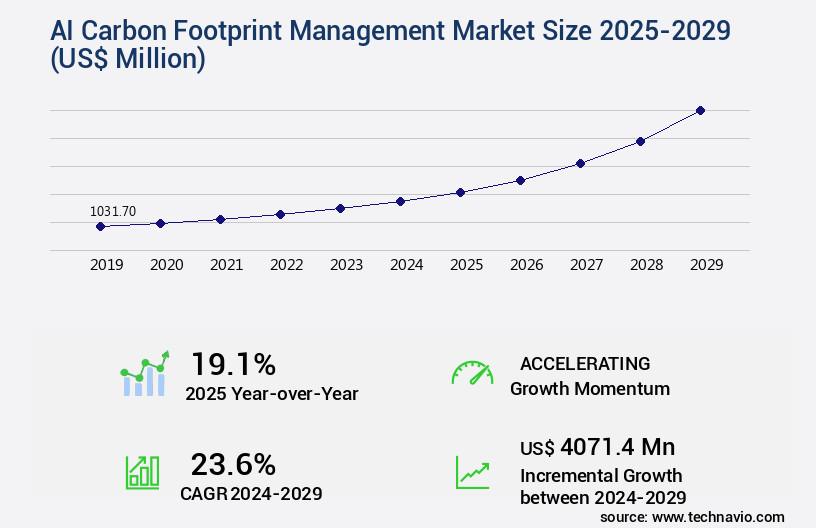
Get Key Insights on Market Forecast (PDF) Request Free Sample
How is the AI Carbon Footprint Management Market Segmented ?
The AI carbon footprint management industry research report provides comprehensive data (region-wise segment analysis), with forecasts and estimates in "USD million" for the period 2025-2029, as well as historical data from 2019-2023 for the following segments.
- Deployment
- Type
- Carbon accounting and measurement
- Scope 1/2/3 emissions tracking
- Real-time data analytics
- AI-driven forecasting
- End-user
- Energy and utilities
- Manufacturing
- Transportation and logistics
- Geography
- North America
- Europe
- APAC
- Rest of World (ROW)
By Deployment Insights
The cloud-based segment is estimated to witness significant growth during the forecast period.
The market continues to evolve, with the cloud-based segment leading the charge. According to recent market research, this segment is projected to expand at a compound annual growth rate of 20% through 2027. The cloud-based model, delivered via Software as a Service (SaaS), offers numerous advantages. It significantly reduces upfront capital expenditure, as organizations avoid the costs of purchasing and maintaining their own server hardware and software licenses. This shift from capital to operational budgets is a key factor driving its popularity. Cloud-based AI solutions integrate IoT sensor data, enabling real-time monitoring of emissions and operational efficiency improvements.
They employ data visualization dashboards, machine learning algorithms, and predictive modeling tools to facilitate carbon accounting methodologies. These platforms optimize energy consumption modeling, waste management, and transportation, all critical components of climate change mitigation. They also facilitate sustainability reporting frameworks, emissions reduction strategies, and carbon pricing mechanisms. Moreover, these systems support decarbonization pathways, including renewable energy integration, circular economy principles, and carbon sequestration technologies. They provide automated reporting systems, material flow analysis, and emissions intensity metrics. With cloud-based data storage, organizations can access their carbon footprint data from anywhere, enabling continuous monitoring and improvement. The market's ongoing evolution reflects the increasing importance of AI in managing and reducing carbon emissions.
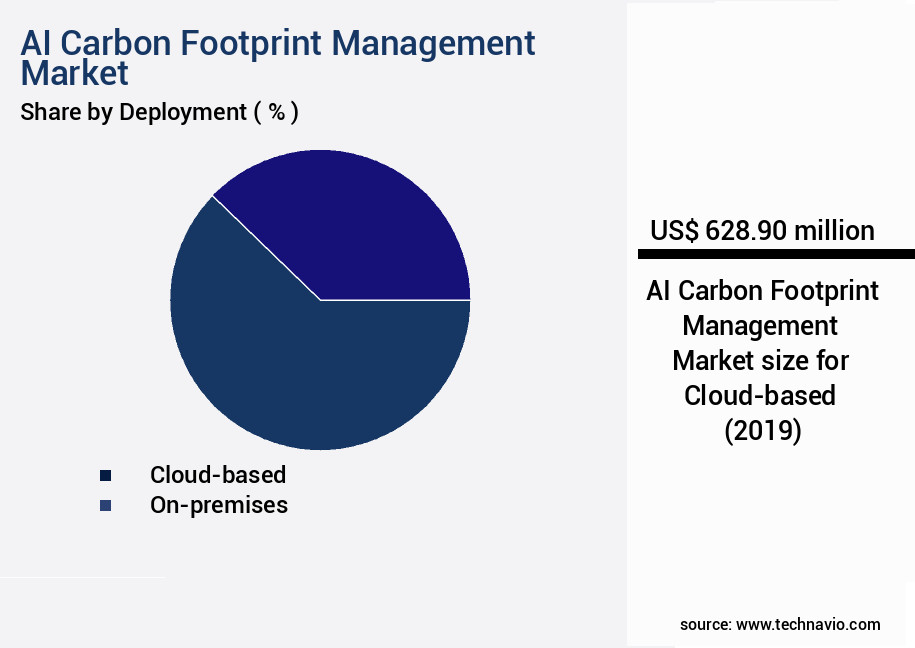
Request Free Sample
The Cloud-based segment was valued at USD 628.90 billion in 2019 and showed a gradual increase during the forecast period.
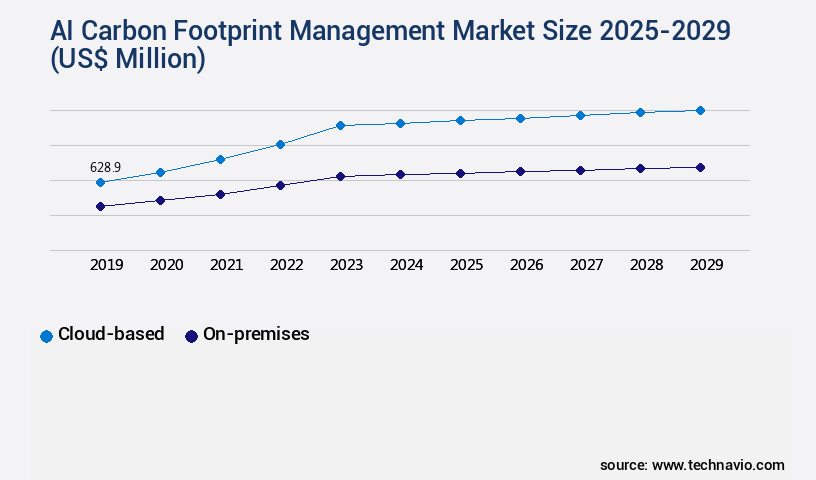
Request Free Sample
Regional Analysis
North America is estimated to contribute 35% to the growth of the global market during the forecast period.Technavio's analysts have elaborately explained the regional trends and drivers that shape the market during the forecast period.
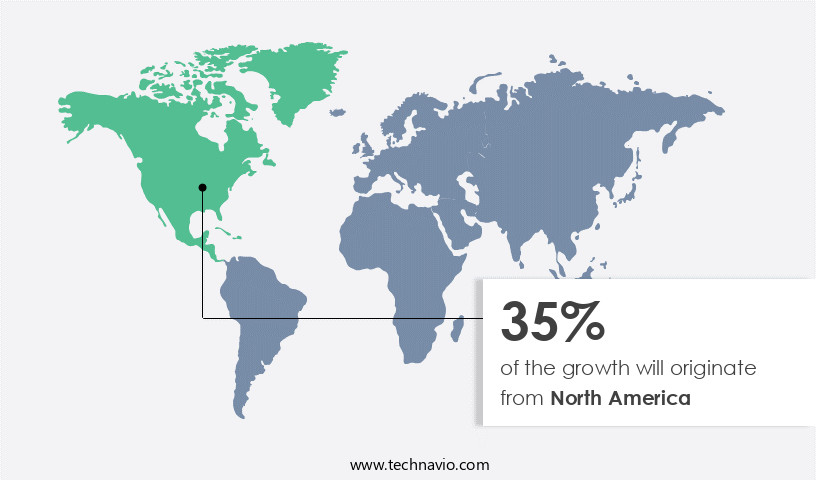
See How AI Carbon Footprint Management Market Demand is Rising in North America Request Free Sample
The market is experiencing significant evolution, with North America emerging as a leading and dynamic regional hub. This region's robust growth can be attributed to a dual-engine of corporate-led innovation and a fragmented yet stringent regulatory landscape. The United States, in particular, is home to influential technology corporations and a thriving venture capital ecosystem, fostering the growth of specialized carbon accounting startups. This competitive environment drives rapid innovation in AI, data analytics, and user experience. Corporate adoption is primarily driven by institutional investors' pressure and a proactive approach to managing climate-related risks and opportunities.
According to recent studies, the North American market is projected to account for over 40% of the global market share by 2027. These figures underscore the market's potential and the significant role North America plays in its development.
Market Dynamics
Our researchers analyzed the data with 2024 as the base year, along with the key drivers, trends, and challenges. A holistic analysis of drivers will help companies refine their marketing strategies to gain a competitive advantage.
The market is experiencing significant growth as businesses seek innovative solutions to reduce their environmental impact. AI-powered carbon footprint reduction strategies are gaining popularity, with machine learning algorithms being used for emissions tracking and reporting. IoT sensors are integrated into operations for real-time emissions monitoring, providing valuable data for analysis. Data analytics plays a crucial role in decarbonizing supply chains, enabling businesses to identify areas of improvement and optimize energy consumption for emissions reduction. AI-driven life cycle assessment tools help assess the environmental impact of products, while predictive modeling enables organizations to anticipate and mitigate future carbon emissions. Carbon accounting software is essential for businesses looking to manage their operational carbon footprint effectively. Cloud-based platforms for carbon data management offer scalability and flexibility, making it easier for organizations to integrate renewable energy sources into their operations.
Automated reporting of greenhouse gas emissions ensures transparency and compliance with regulatory requirements. Developing decarbonization pathways for organizations is a key focus of the market. Strategies for reducing scope 3 emissions, improving waste management practices for sustainability, and implementing circular economy principles in supply chains are all critical components of a comprehensive carbon reduction strategy. Corporate social responsibility reporting on carbon is becoming increasingly important, and effective carbon offsetting programs are essential for businesses looking to neutralize their carbon footprint. By integrating these solutions into their operations, businesses can improve their sustainability, reduce costs, and enhance their reputation as responsible corporate citizens.
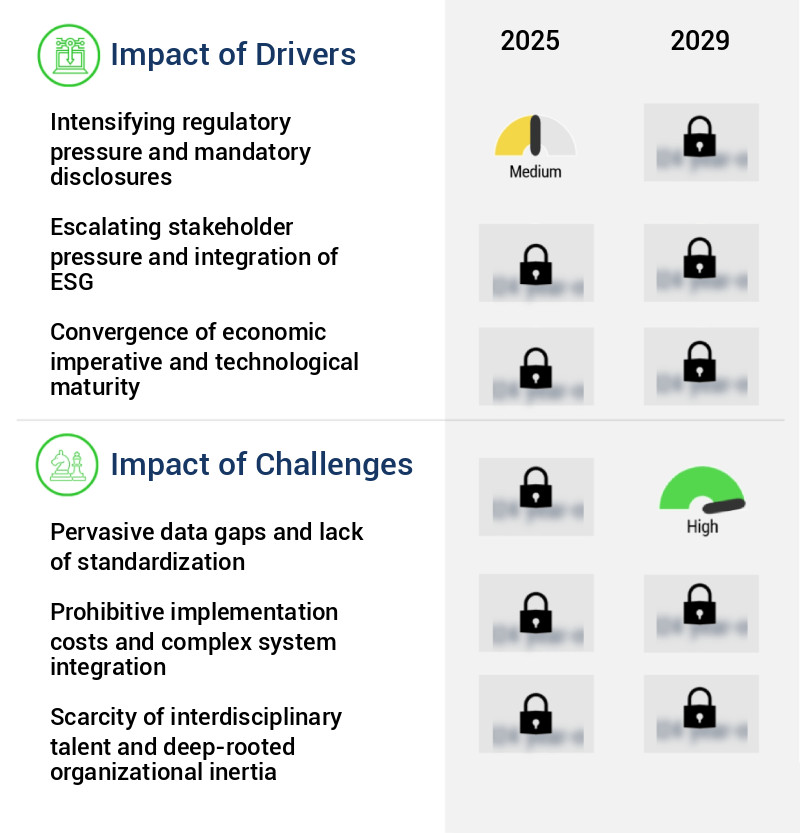
What are the key market drivers leading to the rise in the adoption of AI Carbon Footprint Management Industry?
- The intensification of regulatory pressure and mandatory disclosures serves as the primary catalyst for market developments.
- The market is experiencing significant growth due to the increasing regulatory mandates for climate and sustainability disclosure. Governments and regulatory bodies worldwide are transitioning from voluntary reporting to mandatory, standardized, and auditable climate accounting, which necessitates sophisticated AI-powered solutions. Traditional methods of carbon tracking, such as spreadsheets, are insufficient due to the complexity and data intensity of these new regulations. These regulations go beyond reporting a single top-line emissions number; they require granular, verifiable data across an organization's entire value chain, including challenging-to-measure Scope 3 emissions.
- The market's evolution is a response to the urgent demand for advanced tools to navigate the intricacies of climate accounting and ensure regulatory compliance.
What are the market trends shaping the AI Carbon Footprint Management Industry?
- The emergence of generative AI as a strategic co-pilot for decarbonization is an emerging market trend. This technological advancement is poised to significantly contribute to the decarbonization process.
- The market is experiencing a transformative shift, with the integration of generative artificial intelligence (AI) becoming a prominent trend. Traditionally, AI was utilized as a retrospective data analytics engine, focusing on automating data ingestion and identifying historical emission patterns. However, the advent of generative AI introduces a new dimension, making it a proactive, conversational, and strategic co-pilot. This evolution is marked by the deployment of large language models within carbon management platforms, allowing users to interact with complex datasets using natural language queries. Executives, sustainability managers, and operations leaders no longer need specialized knowledge of data analytics or report building to ask sophisticated what-if questions directly.
- According to recent studies, the global AI in carbon footprint management market is projected to reach significant growth, with an increasing number of organizations recognizing the potential of AI to optimize their carbon emissions and reduce their environmental impact. Additionally, the integration of generative AI is expected to boost the market's efficiency by streamlining data analysis and enabling more accurate and timely decision-making.
What challenges does the AI Carbon Footprint Management Industry face during its growth?
- The absence of pervasive data and standardization poses a significant challenge to the industry's growth, hindering advancements and limiting the potential for innovation and efficiency.
- The market is experiencing significant evolution, driven by the increasing awareness and regulatory pressure to reduce greenhouse gas emissions. AI models play a crucial role in optimizing energy usage and identifying emission reduction opportunities across various sectors. However, the market's growth is impeded by the challenge of data availability, quality, and standardization. Corporate data landscapes are fragmented, inconsistent, and often incomplete, making it difficult for AI models to generate accurate, auditable, and actionable insights. While data for Scope 1 and 2 emissions is becoming more accessible through smart meters and digital utility records, it often resides in siloed operational systems.
- According to recent estimates, over 80% of enterprise data is unstructured, making it challenging to leverage for AI applications. To address this issue, organizations are investing in data integration and standardization solutions, enabling AI models to effectively manage and reduce their carbon footprint.
Exclusive Technavio Analysis on Customer Landscape
The ai carbon footprint management market forecasting report includes the adoption lifecycle of the market, covering from the innovator's stage to the laggard's stage. It focuses on adoption rates in different regions based on penetration. Furthermore, the ai carbon footprint management market report also includes key purchase criteria and drivers of price sensitivity to help companies evaluate and develop their market growth analysis strategies.
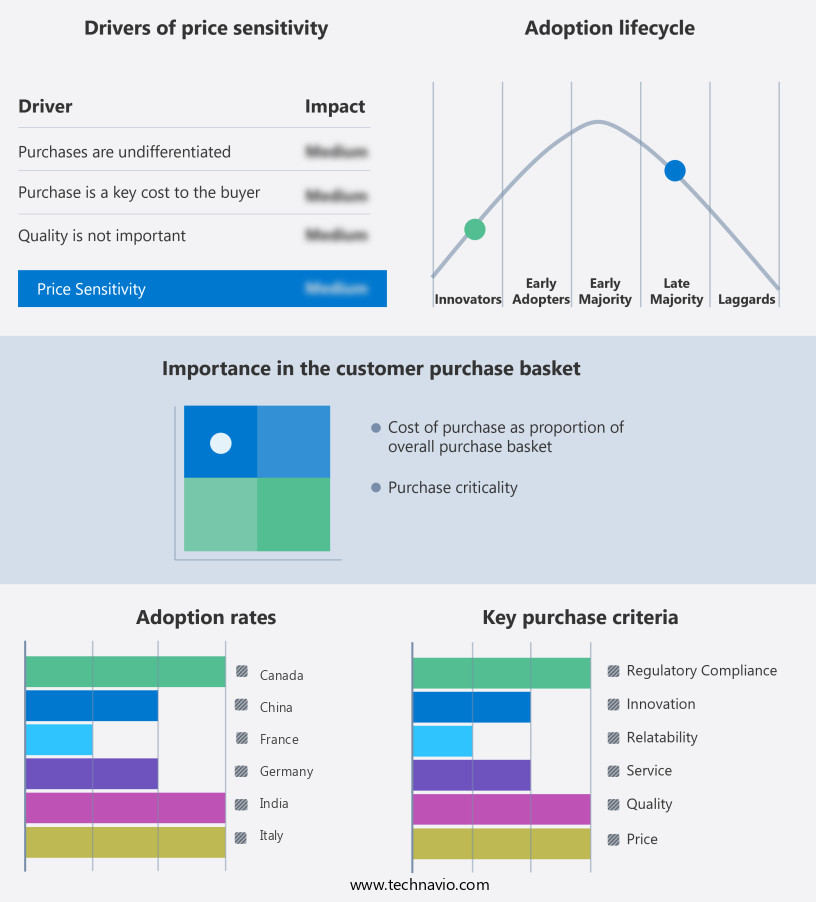
Customer Landscape of AI Carbon Footprint Management Industry
Competitive Landscape
Companies are implementing various strategies, such as strategic alliances, ai carbon footprint management market forecast, partnerships, mergers and acquisitions, geographical expansion, and product/service launches, to enhance their presence in the industry.
AiDash Inc. - The AiDash Intelligent Sustainability Platform is a pioneering AI solution for carbon footprint management in utilities and forestry sectors. Utilizing advanced AI technology and satellite imagery, it delivers accurate emissions monitoring and analysis. This innovative tool empowers businesses to reduce their carbon impact effectively.
The industry research and growth report includes detailed analyses of the competitive landscape of the market and information about key companies, including:
- AiDash Inc.
- Amazon.com Inc.
- Boomitra
- CarbonChain.io Ltd.
- CarbonCloud
- Carbonstop Technology Co. Ltd.
- Climatiq Technologies GmbH
- CO2 AI
- ENGIE SA
- Greenly
- International Business Machines Corp.
- Normative AB
- OCELL GmbH
- Persefoni AI Inc.
- Salesforce Inc.
- SAP SE
- Schneider Electric SE
- SINAI
- Sweep
- Watershed Technology Inc.
Qualitative and quantitative analysis of companies has been conducted to help clients understand the wider business environment as well as the strengths and weaknesses of key industry players. Data is qualitatively analyzed to categorize companies as pure play, category-focused, industry-focused, and diversified; it is quantitatively analyzed to categorize companies as dominant, leading, strong, tentative, and weak.
Recent Development and News in AI Carbon Footprint Management Market
- In August 2024, Carbon Intelligence, a leading AI carbon footprint management company, announced the launch of its new AI-powered carbon accounting solution, "CarbonAI," designed to help businesses automate and streamline their carbon reporting processes. The solution leverages machine learning algorithms to analyze energy usage, transportation data, and supply chain emissions, providing accurate and actionable insights to reduce carbon emissions (Carbon Intelligence Press Release).
- In November 2024, IBM and Microsoft, two tech giants, joined forces to collaborate on AI carbon footprint management. They aim to integrate their respective technologies, IBM's environmental intelligence platform and Microsoft's Azure AI, to offer more comprehensive carbon management solutions for businesses (IBM Press Release).
- In February 2025, Siemens Energy, a global energy technology leader, secured a strategic investment of €100 million from E.ON, a leading energy producer, to expand its AI carbon footprint management services. This collaboration will enable Siemens Energy to offer more customized and scalable solutions to its clients (Siemens Energy Press Release).
- In May 2025, the European Union passed the Carbon Border Adjustment Mechanism (CBAM) regulation, which mandates carbon pricing for imported goods based on their carbon footprint. This initiative is expected to drive increased demand for AI carbon footprint management solutions to help businesses accurately assess and report their carbon emissions (European Parliament Press Release).
Dive into Technavio's robust research methodology, blending expert interviews, extensive data synthesis, and validated models for unparalleled AI Carbon Footprint Management Market insights. See full methodology.
|
Market Scope
|
|
Report Coverage
|
Details
|
|
Page number
|
234
|
|
Base year
|
2024
|
|
Historic period
|
2019-2023 |
|
Forecast period
|
2025-2029
|
|
Growth momentum & CAGR
|
Accelerate at a CAGR of 23.6%
|
|
Market growth 2025-2029
|
USD 4071.4 million
|
|
Market structure
|
Fragmented
|
|
YoY growth 2024-2025(%)
|
19.1
|
|
Key countries
|
US, Canada, China, Germany, UK, Mexico, France, Japan, Italy, and India
|
|
Competitive landscape
|
Leading Companies, Market Positioning of Companies, Competitive Strategies, and Industry Risks
|
Request Free Sample
Research Analyst Overview
- The market continues to evolve, driven by the increasing demand for sustainable business practices and the integration of advanced technologies. Companies are increasingly focusing on Scope 1 and 2 emissions data to identify and reduce their carbon footprint. IoT sensor integration enables real-time monitoring of energy consumption and emissions, leading to operational efficiency improvements. Carbon sequestration technologies and circular economy principles are gaining traction as businesses seek to minimize their environmental impact. Emissions intensity metrics and AI-driven carbon tracking help identify areas for improvement, while process optimization techniques and climate change mitigation strategies are key to reducing carbon emissions.
- Energy consumption modeling and waste management optimization are essential components of carbon accounting methodologies. Renewable energy integration and carbon pricing mechanisms are also becoming more prevalent as businesses seek to decarbonize their operations. Predictive modeling tools and sustainability reporting frameworks enable businesses to assess their environmental impact and set decarbonization pathways. Data analytics platforms and automated reporting systems streamline the carbon footprint calculation process, making it more accessible to businesses of all sizes. Water usage optimization and machine learning algorithms are also important areas of focus, as businesses strive to minimize their overall environmental impact. Scope 3 emissions data and sustainability performance indicators are increasingly being considered as businesses look to decarbonize their entire value chain.
- According to recent estimates, the market is expected to grow by over 20% annually in the coming years. For instance, a leading manufacturing company was able to reduce its energy consumption by 15% through the implementation of AI-driven energy management systems. This not only resulted in significant cost savings but also contributed to the company's sustainability goals.
What are the Key Data Covered in this AI Carbon Footprint Management Market Research and Growth Report?
-
What is the expected growth of the AI Carbon Footprint Management Market between 2025 and 2029?
-
What segmentation does the market report cover?
-
The report is segmented by Deployment (Cloud-based and On-premises), Type (Carbon accounting and measurement, Scope 1/2/3 emissions tracking, Real-time data analytics, and AI-driven forecasting), End-user (Energy and utilities, Manufacturing, and Transportation and logistics), and Geography (North America, Europe, APAC, South America, and Middle East and Africa)
-
Which regions are analyzed in the report?
-
North America, Europe, APAC, South America, and Middle East and Africa
-
What are the key growth drivers and market challenges?
-
Who are the major players in the AI Carbon Footprint Management Market?
-
AiDash Inc., Amazon.com Inc., Boomitra, CarbonChain.io Ltd., CarbonCloud, Carbonstop Technology Co. Ltd., Climatiq Technologies GmbH, CO2 AI, ENGIE SA, Greenly, International Business Machines Corp., Normative AB, OCELL GmbH, Persefoni AI Inc., Salesforce Inc., SAP SE, Schneider Electric SE, SINAI, Sweep, and Watershed Technology Inc.
Market Research Insights
- The market for AI carbon footprint management solutions continues to expand, driven by the increasing demand for businesses to reduce their environmental impact. According to recent reports, the global market for carbon accounting software is projected to grow by 15% annually over the next decade. For instance, a leading manufacturing company was able to decrease its carbon emissions by 20% through the implementation of an AI-powered carbon management system. This technology not only helps organizations meet regulatory requirements but also provides valuable data-driven insights for strategic planning and operational risk reduction.
- Furthermore, the integration of AI in carbon footprint management leads to process automation and efficiency gains, making it an essential tool for companies seeking to improve their sustainability metrics and enhance their stakeholder engagement.
We can help! Our analysts can customize this AI carbon footprint management market research report to meet your requirements.
Get in touch
1 Executive Summary
- 1.1 Market overview
- Executive Summary - Chart on Market Overview
- Executive Summary - Data Table on Market Overview
- Executive Summary - Chart on Global Market Characteristics
- Executive Summary - Chart on Market by Geography
- Executive Summary - Chart on Market Segmentation by Deployment
- Executive Summary - Chart on Market Segmentation by Type
- Executive Summary - Chart on Market Segmentation by End-user
- Executive Summary - Chart on Incremental Growth
- Executive Summary - Data Table on Incremental Growth
- Executive Summary - Chart on Company Market Positioning
2 Technavio Analysis
- 2.1 Analysis of price sensitivity, lifecycle, customer purchase basket, adoption rates, and purchase criteria
- Analysis of price sensitivity, lifecycle, customer purchase basket, adoption rates, and purchase criteria
- 2.2 Criticality of inputs and Factors of differentiation
- Overview on criticality of inputs and factors of differentiation
- 2.3 Factors of disruption
- Overview on factors of disruption
- 2.4 Impact of drivers and challenges
- Impact of drivers and challenges in 2024 and 2029
3 Market Landscape
- 3.1 Market ecosystem
- Parent Market
- Data Table on - Parent Market
- 3.2 Market characteristics
- Market characteristics analysis
4 Market Sizing
- 4.1 Market definition
- Offerings of companies included in the market definition
- 4.2 Market segment analysis
- 4.4 Market outlook: Forecast for 2024-2029
- Chart on Global - Market size and forecast 2024-2029 ($ million)
- Data Table on Global - Market size and forecast 2024-2029 ($ million)
- Chart on Global Market: Year-over-year growth 2024-2029 (%)
- Data Table on Global Market: Year-over-year growth 2024-2029 (%)
5 Historic Market Size
- 5.1 Global AI Carbon Footprint Management Market 2019 - 2023
- Historic Market Size - Data Table on Global AI Carbon Footprint Management Market 2019 - 2023 ($ million)
- 5.2 Deployment segment analysis 2019 - 2023
- Historic Market Size - Deployment Segment 2019 - 2023 ($ million)
- 5.3 Type segment analysis 2019 - 2023
- Historic Market Size - Type Segment 2019 - 2023 ($ million)
- 5.4 End-user segment analysis 2019 - 2023
- Historic Market Size - End-user Segment 2019 - 2023 ($ million)
- 5.5 Geography segment analysis 2019 - 2023
- Historic Market Size - Geography Segment 2019 - 2023 ($ million)
- 5.6 Country segment analysis 2019 - 2023
- Historic Market Size - Country Segment 2019 - 2023 ($ million)
6 Five Forces Analysis
- 6.1 Five forces summary
- Five forces analysis - Comparison between 2024 and 2029
- 6.2 Bargaining power of buyers
- Bargaining power of buyers - Impact of key factors 2024 and 2029
- 6.3 Bargaining power of suppliers
- Bargaining power of suppliers - Impact of key factors in 2024 and 2029
- 6.4 Threat of new entrants
- Threat of new entrants - Impact of key factors in 2024 and 2029
- 6.5 Threat of substitutes
- Threat of substitutes - Impact of key factors in 2024 and 2029
- 6.6 Threat of rivalry
- Threat of rivalry - Impact of key factors in 2024 and 2029
- 6.7 Market condition
- Chart on Market condition - Five forces 2024 and 2029
7 Market Segmentation by Deployment
- 7.1 Market segments
- Chart on Deployment - Market share 2024-2029 (%)
- Data Table on Deployment - Market share 2024-2029 (%)
- 7.2 Comparison by Deployment
- Chart on Comparison by Deployment
- Data Table on Comparison by Deployment
- 7.3 Cloud-based - Market size and forecast 2024-2029
- Chart on Cloud-based - Market size and forecast 2024-2029 ($ million)
- Data Table on Cloud-based - Market size and forecast 2024-2029 ($ million)
- Chart on Cloud-based - Year-over-year growth 2024-2029 (%)
- Data Table on Cloud-based - Year-over-year growth 2024-2029 (%)
- 7.4 On-premises - Market size and forecast 2024-2029
- Chart on On-premises - Market size and forecast 2024-2029 ($ million)
- Data Table on On-premises - Market size and forecast 2024-2029 ($ million)
- Chart on On-premises - Year-over-year growth 2024-2029 (%)
- Data Table on On-premises - Year-over-year growth 2024-2029 (%)
- 7.5 Market opportunity by Deployment
- Market opportunity by Deployment ($ million)
- Data Table on Market opportunity by Deployment ($ million)
8 Market Segmentation by Type
- 8.1 Market segments
- Chart on Type - Market share 2024-2029 (%)
- Data Table on Type - Market share 2024-2029 (%)
- 8.2 Comparison by Type
- Chart on Comparison by Type
- Data Table on Comparison by Type
- 8.3 Carbon accounting and measurement - Market size and forecast 2024-2029
- Chart on Carbon accounting and measurement - Market size and forecast 2024-2029 ($ million)
- Data Table on Carbon accounting and measurement - Market size and forecast 2024-2029 ($ million)
- Chart on Carbon accounting and measurement - Year-over-year growth 2024-2029 (%)
- Data Table on Carbon accounting and measurement - Year-over-year growth 2024-2029 (%)
- 8.4 Scope 1/2/3 emissions tracking - Market size and forecast 2024-2029
- Chart on Scope 1/2/3 emissions tracking - Market size and forecast 2024-2029 ($ million)
- Data Table on Scope 1/2/3 emissions tracking - Market size and forecast 2024-2029 ($ million)
- Chart on Scope 1/2/3 emissions tracking - Year-over-year growth 2024-2029 (%)
- Data Table on Scope 1/2/3 emissions tracking - Year-over-year growth 2024-2029 (%)
- 8.5 Real-time data analytics - Market size and forecast 2024-2029
- Chart on Real-time data analytics - Market size and forecast 2024-2029 ($ million)
- Data Table on Real-time data analytics - Market size and forecast 2024-2029 ($ million)
- Chart on Real-time data analytics - Year-over-year growth 2024-2029 (%)
- Data Table on Real-time data analytics - Year-over-year growth 2024-2029 (%)
- 8.6 AI-driven forecasting - Market size and forecast 2024-2029
- Chart on AI-driven forecasting - Market size and forecast 2024-2029 ($ million)
- Data Table on AI-driven forecasting - Market size and forecast 2024-2029 ($ million)
- Chart on AI-driven forecasting - Year-over-year growth 2024-2029 (%)
- Data Table on AI-driven forecasting - Year-over-year growth 2024-2029 (%)
- 8.7 Market opportunity by Type
- Market opportunity by Type ($ million)
- Data Table on Market opportunity by Type ($ million)
9 Market Segmentation by End-user
- 9.1 Market segments
- Chart on End-user - Market share 2024-2029 (%)
- Data Table on End-user - Market share 2024-2029 (%)
- 9.2 Comparison by End-user
- Chart on Comparison by End-user
- Data Table on Comparison by End-user
- 9.3 Energy and utilities - Market size and forecast 2024-2029
- Chart on Energy and utilities - Market size and forecast 2024-2029 ($ million)
- Data Table on Energy and utilities - Market size and forecast 2024-2029 ($ million)
- Chart on Energy and utilities - Year-over-year growth 2024-2029 (%)
- Data Table on Energy and utilities - Year-over-year growth 2024-2029 (%)
- 9.4 Manufacturing - Market size and forecast 2024-2029
- Chart on Manufacturing - Market size and forecast 2024-2029 ($ million)
- Data Table on Manufacturing - Market size and forecast 2024-2029 ($ million)
- Chart on Manufacturing - Year-over-year growth 2024-2029 (%)
- Data Table on Manufacturing - Year-over-year growth 2024-2029 (%)
- 9.5 Transportation and logistics - Market size and forecast 2024-2029
- Chart on Transportation and logistics - Market size and forecast 2024-2029 ($ million)
- Data Table on Transportation and logistics - Market size and forecast 2024-2029 ($ million)
- Chart on Transportation and logistics - Year-over-year growth 2024-2029 (%)
- Data Table on Transportation and logistics - Year-over-year growth 2024-2029 (%)
- 9.6 Market opportunity by End-user
- Market opportunity by End-user ($ million)
- Data Table on Market opportunity by End-user ($ million)
10 Customer Landscape
- 10.1 Customer landscape overview
- Analysis of price sensitivity, lifecycle, customer purchase basket, adoption rates, and purchase criteria
11 Geographic Landscape
- 11.1 Geographic segmentation
- Chart on Market share by geography 2024-2029 (%)
- Data Table on Market share by geography 2024-2029 (%)
- 11.2 Geographic comparison
- Chart on Geographic comparison
- Data Table on Geographic comparison
- 11.3 North America - Market size and forecast 2024-2029
- Chart on North America - Market size and forecast 2024-2029 ($ million)
- Data Table on North America - Market size and forecast 2024-2029 ($ million)
- Chart on North America - Year-over-year growth 2024-2029 (%)
- Data Table on North America - Year-over-year growth 2024-2029 (%)
- 11.4 Europe - Market size and forecast 2024-2029
- Chart on Europe - Market size and forecast 2024-2029 ($ million)
- Data Table on Europe - Market size and forecast 2024-2029 ($ million)
- Chart on Europe - Year-over-year growth 2024-2029 (%)
- Data Table on Europe - Year-over-year growth 2024-2029 (%)
- 11.5 APAC - Market size and forecast 2024-2029
- Chart on APAC - Market size and forecast 2024-2029 ($ million)
- Data Table on APAC - Market size and forecast 2024-2029 ($ million)
- Chart on APAC - Year-over-year growth 2024-2029 (%)
- Data Table on APAC - Year-over-year growth 2024-2029 (%)
- 11.6 South America - Market size and forecast 2024-2029
- Chart on South America - Market size and forecast 2024-2029 ($ million)
- Data Table on South America - Market size and forecast 2024-2029 ($ million)
- Chart on South America - Year-over-year growth 2024-2029 (%)
- Data Table on South America - Year-over-year growth 2024-2029 (%)
- 11.7 Middle East and Africa - Market size and forecast 2024-2029
- Chart on Middle East and Africa - Market size and forecast 2024-2029 ($ million)
- Data Table on Middle East and Africa - Market size and forecast 2024-2029 ($ million)
- Chart on Middle East and Africa - Year-over-year growth 2024-2029 (%)
- Data Table on Middle East and Africa - Year-over-year growth 2024-2029 (%)
- 11.8 US - Market size and forecast 2024-2029
- Chart on US - Market size and forecast 2024-2029 ($ million)
- Data Table on US - Market size and forecast 2024-2029 ($ million)
- Chart on US - Year-over-year growth 2024-2029 (%)
- Data Table on US - Year-over-year growth 2024-2029 (%)
- 11.9 Canada - Market size and forecast 2024-2029
- Chart on Canada - Market size and forecast 2024-2029 ($ million)
- Data Table on Canada - Market size and forecast 2024-2029 ($ million)
- Chart on Canada - Year-over-year growth 2024-2029 (%)
- Data Table on Canada - Year-over-year growth 2024-2029 (%)
- 11.10 China - Market size and forecast 2024-2029
- Chart on China - Market size and forecast 2024-2029 ($ million)
- Data Table on China - Market size and forecast 2024-2029 ($ million)
- Chart on China - Year-over-year growth 2024-2029 (%)
- Data Table on China - Year-over-year growth 2024-2029 (%)
- 11.11 Germany - Market size and forecast 2024-2029
- Chart on Germany - Market size and forecast 2024-2029 ($ million)
- Data Table on Germany - Market size and forecast 2024-2029 ($ million)
- Chart on Germany - Year-over-year growth 2024-2029 (%)
- Data Table on Germany - Year-over-year growth 2024-2029 (%)
- 11.12 UK - Market size and forecast 2024-2029
- Chart on UK - Market size and forecast 2024-2029 ($ million)
- Data Table on UK - Market size and forecast 2024-2029 ($ million)
- Chart on UK - Year-over-year growth 2024-2029 (%)
- Data Table on UK - Year-over-year growth 2024-2029 (%)
- 11.13 Mexico - Market size and forecast 2024-2029
- Chart on Mexico - Market size and forecast 2024-2029 ($ million)
- Data Table on Mexico - Market size and forecast 2024-2029 ($ million)
- Chart on Mexico - Year-over-year growth 2024-2029 (%)
- Data Table on Mexico - Year-over-year growth 2024-2029 (%)
- 11.14 France - Market size and forecast 2024-2029
- Chart on France - Market size and forecast 2024-2029 ($ million)
- Data Table on France - Market size and forecast 2024-2029 ($ million)
- Chart on France - Year-over-year growth 2024-2029 (%)
- Data Table on France - Year-over-year growth 2024-2029 (%)
- 11.15 Japan - Market size and forecast 2024-2029
- Chart on Japan - Market size and forecast 2024-2029 ($ million)
- Data Table on Japan - Market size and forecast 2024-2029 ($ million)
- Chart on Japan - Year-over-year growth 2024-2029 (%)
- Data Table on Japan - Year-over-year growth 2024-2029 (%)
- 11.16 Italy - Market size and forecast 2024-2029
- Chart on Italy - Market size and forecast 2024-2029 ($ million)
- Data Table on Italy - Market size and forecast 2024-2029 ($ million)
- Chart on Italy - Year-over-year growth 2024-2029 (%)
- Data Table on Italy - Year-over-year growth 2024-2029 (%)
- 11.17 India - Market size and forecast 2024-2029
- Chart on India - Market size and forecast 2024-2029 ($ million)
- Data Table on India - Market size and forecast 2024-2029 ($ million)
- Chart on India - Year-over-year growth 2024-2029 (%)
- Data Table on India - Year-over-year growth 2024-2029 (%)
- 11.18 Market opportunity by geography
- Market opportunity by geography ($ million)
- Data Tables on Market opportunity by geography ($ million)
12 Drivers, Challenges, and Opportunity/Restraints
- 12.3 Impact of drivers and challenges
- Impact of drivers and challenges in 2024 and 2029
- 12.4 Market opportunities/restraints
13 Competitive Landscape
- 13.2 Competitive Landscape
- Overview on criticality of inputs and factors of differentiation
- 13.3 Landscape disruption
- Overview on factors of disruption
- 13.4 Industry risks
- Impact of key risks on business
14 Competitive Analysis
- 14.2 Company ranking index
- 14.3 Market positioning of companies
- Matrix on companies position and classification
- 14.4 AiDash Inc.
- AiDash Inc. - Overview
- AiDash Inc. - Product / Service
- AiDash Inc. - Key offerings
- SWOT
- 14.5 Amazon.com Inc.
- Amazon.com Inc. - Overview
- Amazon.com Inc. - Business segments
- Amazon.com Inc. - Key news
- Amazon.com Inc. - Key offerings
- Amazon.com Inc. - Segment focus
- SWOT
- 14.6 Boomitra
- Boomitra - Overview
- Boomitra - Product / Service
- Boomitra - Key offerings
- SWOT
- 14.7 CarbonChain.io Ltd.
- CarbonChain.io Ltd. - Overview
- CarbonChain.io Ltd. - Product / Service
- CarbonChain.io Ltd. - Key offerings
- SWOT
- 14.8 CarbonCloud
- CarbonCloud - Overview
- CarbonCloud - Product / Service
- CarbonCloud - Key offerings
- SWOT
- 14.9 Climatiq Technologies GmbH
- Climatiq Technologies GmbH - Overview
- Climatiq Technologies GmbH - Product / Service
- Climatiq Technologies GmbH - Key offerings
- SWOT
- 14.10 CO2 AI
- CO2 AI - Overview
- CO2 AI - Product / Service
- CO2 AI - Key offerings
- SWOT
- 14.11 ENGIE SA
- ENGIE SA - Overview
- ENGIE SA - Business segments
- ENGIE SA - Key offerings
- ENGIE SA - Segment focus
- SWOT
- 14.12 International Business Machines Corp.
- International Business Machines Corp. - Overview
- International Business Machines Corp. - Business segments
- International Business Machines Corp. - Key news
- International Business Machines Corp. - Key offerings
- International Business Machines Corp. - Segment focus
- SWOT
- 14.13 Persefoni AI Inc.
- Persefoni AI Inc. - Overview
- Persefoni AI Inc. - Product / Service
- Persefoni AI Inc. - Key offerings
- SWOT
- 14.14 Salesforce Inc.
- Salesforce Inc. - Overview
- Salesforce Inc. - Product / Service
- Salesforce Inc. - Key news
- Salesforce Inc. - Key offerings
- SWOT
- 14.15 SAP SE
- SAP SE - Overview
- SAP SE - Business segments
- SAP SE - Key news
- SAP SE - Key offerings
- SAP SE - Segment focus
- SWOT
- 14.16 Schneider Electric SE
- Schneider Electric SE - Overview
- Schneider Electric SE - Business segments
- Schneider Electric SE - Key news
- Schneider Electric SE - Key offerings
- Schneider Electric SE - Segment focus
- SWOT
- 14.17 SINAI
- SINAI - Overview
- SINAI - Product / Service
- SINAI - Key offerings
- SWOT
- 14.18 Watershed Technology Inc.
- Watershed Technology Inc. - Overview
- Watershed Technology Inc. - Product / Service
- Watershed Technology Inc. - Key offerings
- SWOT
15 Appendix
- 15.2 Inclusions and exclusions checklist
- Inclusions checklist
- Exclusions checklist
- 15.3 Currency conversion rates for US$
- Currency conversion rates for US$
- 15.4 Research methodology
- 15.7 Validation techniques employed for market sizing
- Validation techniques employed for market sizing
- 15.9 360 degree market analysis
- 360 degree market analysis
- 15.10 List of abbreviations







![]() Get the report (PDF) sent to your email within minutes.
Get the report (PDF) sent to your email within minutes.
Complimentary full Excel data with your report purchase.